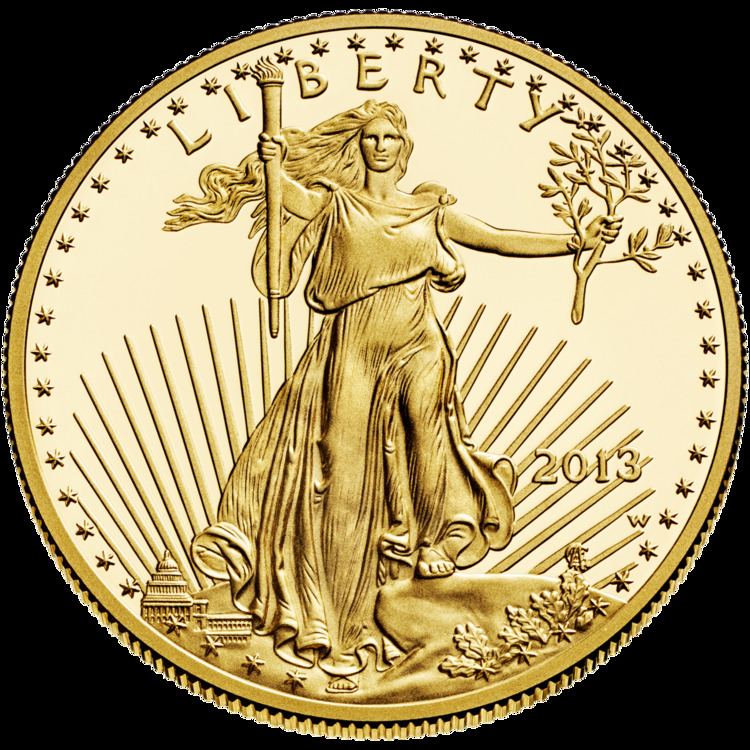 | ||
The American gold eagle is an official gold bullion coin of the United States. Authorized under the Gold Bullion Coin Act of 1985, it was first released by the United States Mint in 1986. Because the term "eagle" also is the official United States designation for pre-1933 ten dollars gold coins, the weight of the bullion coin is typically used when describing American gold eagles (e.g., "1/2-ounce American gold eagle") to avoid confusion. This is particularly true with the 1/4-oz American gold eagle, which has a marked face value of ten dollars.
Contents
Details
Offered in 1/10 oz, 1/4 oz, 1/2 oz, and 1 oz denominations, these coins are guaranteed by the U.S. government to contain the stated amount of actual gold weight in troy ounces. By law, the gold must come from sources in America, alloyed with silver and copper to produce a more wear-resistant coin.
The 22 kt gold alloy is an English standard traditionally referred to as "crown gold". Crown gold alloys had not been used in U.S. coins since 1834, with the gold content having dropped since 1837 to a standard of 0.900 fine for U.S. gold coins. For American gold eagles the gold fraction was increased again to .9167 or (22 karat). It is authorized by the United States Congress and is backed by the United States Mint for weight and content.
The obverse design features a rendition of Augustus Saint-Gaudens' full length figure of Lady Liberty with flowing hair, holding a torch in her right hand and an olive branch in her left, with the Capitol building in the left background. The design is taken from the $20 Saint-Gaudens gold coin which was commissioned by Theodore Roosevelt to create coins like the ancient Greek and Roman coins. The reverse design, by sculptor Miley Busiek, features a male eagle carrying an olive branch flying above a nest containing a female eagle and her hatchlings.
Value
The market value of the coins is generally about equal to the market value of their gold content, not their face value. Like all commodities, this value fluctuates with market forces. The face values are proportional to the weights except for the 1/4 oz coin. Their actual selling prices vary based on the current spot price of gold. The United States Mint also produces proof and uncirculated versions for coin collectors. These coins are produced at the West Point Mint in West Point, New York. The proof and uncirculated versions carry the mint's mark ("W") beneath the date.
Specifications
Each of the four sizes contains 91.67% gold (22 karat), 3% silver, and 5.33% copper.
Gold eagles minted 1986–1991 are dated with Roman numerals. In 1992, the U.S. Mint switched to Arabic numbers for dating gold eagles.
The 1/10, 1/4, and 1/2 troy oz coins are identical in design to the 1 troy oz coin except for the markings on the reverse side that indicate the weight and face value of the coin (for example, 1 OZ. fine gold~50 dollars).
These bullion coins carry face values of $5, $10, $25, and $50. These are their legal values reflecting their issue and monetized value as coins. They are legal tender for all debts public and private at their face values. These face values do not reflect their intrinsic value which is much greater and is mainly dictated by their troy weight and the current precious metal price. In 2012 the U.S. Mint sold the 2012 one ounce coin ($50 face value) at $1,835.00.
Mintage
Mintage for bullion coins 1986-2016.
